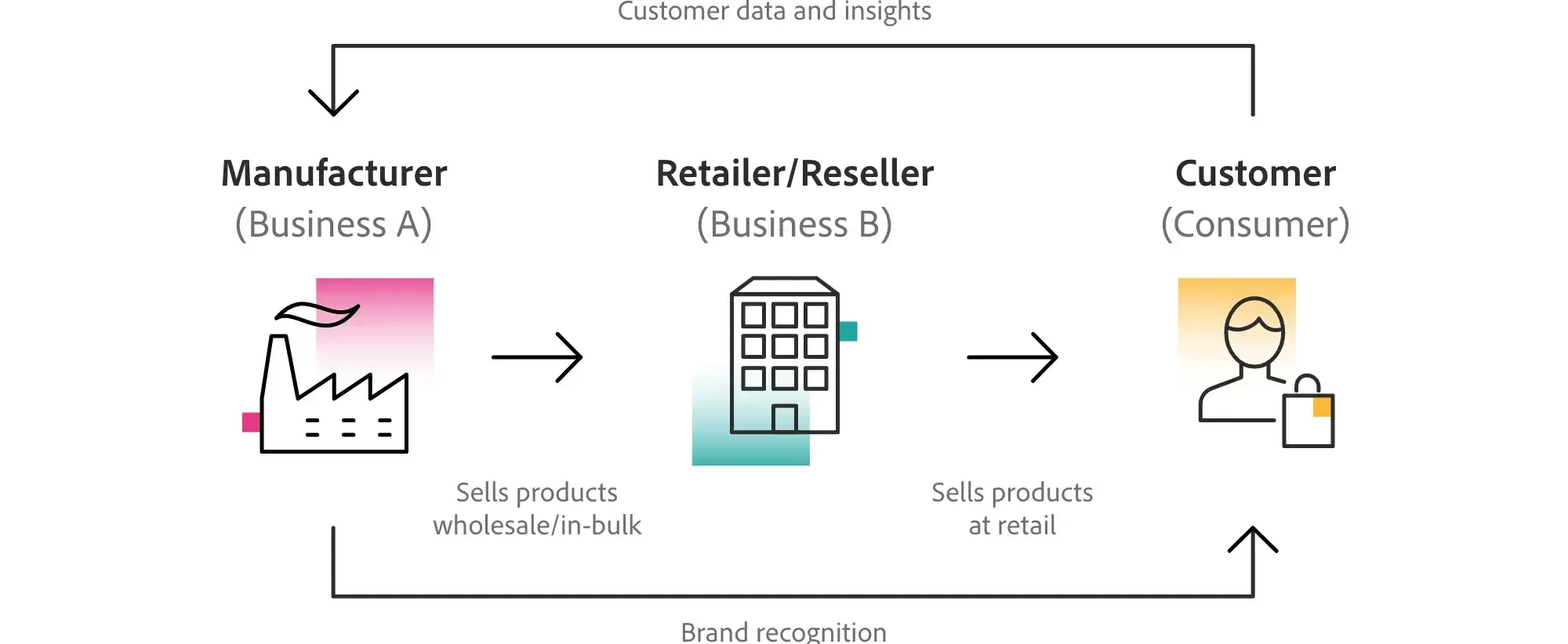As a content writer in the digital marketing space, I spend a lot of time breaking down terms, concepts and strategies in the industry, some of which can be more confusing or harder to understand than others.

However, I also found that some terms, including “B2B2C Marketing”, could looks like may be too complicated at first, but it turns out to be much easier to understand once you research them.
In this post, I will walk you through what B2B2C marketing is and how it works, as well as provide some examples of popular and effective B2B2C marketing strategies.
Content
What is B2B2C marketing?
B2B2C marketing stands for business-to-business marketing. It is a business model and strategy that usually involves a manufacturer selling its products or services to a separate business, which in turn sells products or services to consumers.
It is important that B2B2C marketing differs from B2B or B2C marketing, in which businesses sell exclusively to other businesses or directly to consumers.
B2B2C marketing is actually incredibly common, and most of us regularly work with companies that use this model.
In fact, B2B2C marketing has been around for years, but has become more prevalent over the years as technological innovations have made it easier and more beneficial for companies to collaborate.

Now that I’ve given you a basic definition of B2B2C marketing, let’s look at exactly why – and how – it works and explore some real-world examples.
Why B2B2C Marketing Works
Personally, I have seen how B2B2C marketing takes many forms and is used in different contexts in different industries.
In many cases, these were simple arrangements between two businesses, where the underlying strategies and mutually beneficial nature of the partnerships were incredibly simple.
And in others, the inner workings and processes were much more complex, sometimes involving a product manufacturer, a global distributor and hundreds of independent retail organizations operating around the world.
However, in almost every example I’ve come across, B2B2C marketing strategies tend to follow the same basic set of rules and target similar results. Here are some of the ways this model is useful for businesses.
Shared benefits of partnership and cooperation
The first thing to understand is that B2B2C marketing is essentially a partnership or collaboration between businesses.
These partnerships are usually formed by recognizing that each business has something the other needs or can benefit from.
In most cases, the first business has a particular product, and the second, as an intermediary, has access to consumers who would be interested in buying that product.
Simply put, when B2B2C marketing is used effectively, everyone wins.
Increased brand awareness and growth
It is also important to note that the benefits of B2B2C marketing often go beyond increasing sales.
For one thing, joint content creation and marketing efforts between businesses help build brand awareness and grow each company’s consumer base.
Increased access to consumer data and insights
Additionally, in many cases the first business will gain access to valuable consumer data and insights, allowing them to better identify and understand their target audience. This in turn helps them provide more personalized experiences.
How B2B2C marketing works
Now that I’ve given a general description of why B2B2C marketing works and how it benefits businesses, I’d like to highlight a few examples of companies using this model.
The examples I will share will show how B2B2C marketing strategies can vary by product and/or industry.
B2B2C Marketing Strategy Example 1: Frito-Lay
Frito-Lay is a great company to start with because it offers one of the oldest, most basic iterations of B2B2C marketing.
As a manufacturer of popular snacks, Frito-Lay works with grocery stores around the world, which act as intermediaries that buy, market and sell its products directly to consumers.
One common aspect of B2B2C marketing to keep in mind as we go through these examples is that consumers will always be aware of the partnership.
In this example, when I go to the store to buy my favorite chips, I understand that I am buying the chips from a store, but also that the chips originate from and are produced in one of Frito-Lay’s facilities.
B2B2C Marketing Strategy Example 2: Instacart
Sticking with grocery as a product category, Instacart is another, more modern example of B2B2C marketing in action. In this case, however, the store is the first business, and Instacart is the middleman.
More specifically, if I own and operate a grocery store, I am limited to selling my products to consumers who enter the physical location to purchase groceries.
But by partnering with a delivery service like Instacart, I now have a way to sell my products to people in their own homes, without having to worry about the logistics associated with food delivery.
B2B2C Marketing Strategy Example 3: Apple
Moving on to the tech industry, Apple is a great example to look at for several reasons. First, it engages in various B2B2C strategies related to hardware and digital services.
Second, Apple is an example of a company whose business model consists of B2B, B2Cand B2B2C at once.
On the hardware side, Apple sells its iPhones to telecommunications companies, such as Verizon and T-Mobile, who then sell the iPhones directly to consumers (B2B2C). At the same time, Apple sells its products directly to consumers in its own stores and on its website (B2C).
In terms of digital services, Apple provides its marketplace, the App Store, to software developers who can then sell their mobile applications to consumers (B2B2C).
Meanwhile, Apple also sells its own software solutions and platforms, such as Apple Business Manager, directly to business owners to support their business (B2B).
B2B2C Marketing Strategy Example 4: Amazon
Amazon runs one of the largest and most successful B2B2C marketing operations in the world.
By providing an e-commerce marketplace, along with warehousing, customer support and delivery services, businesses and manufacturers in various industries gain the ability to sell their products to a wider range of consumers than they would otherwise have access to.
It is also worth mentioning that, like Apple, Amazon also manufactures and sells its own products to consumers on its website (B2C), while it also manufactures and distributes its own software solutions for businesses (B2B).
By this point, I hope you have a better understanding of what B2B2C marketing is and how it works in different industries and contexts.
Now I want to examine a few specific strategies that can help businesses maximize the impact of their B2B2C marketing efforts.
3 effective B2B2C marketing strategies
From what I’ve seen, the most successful B2B2C marketing strategies are those where both businesses rely on the collaborative element of their partnership, finding ways that each can benefit while optimizing end-consumer experiences and satisfaction.
For example, I once worked for a small clothing company with a uniquely talented creative team and exclusive access to influential brand ambassadors. But they also had extremely limited capital, e-commerce capabilities and access to consumers.
By teaming up with a much larger, more established fashion brand, they were able to run a collaborative campaign and bring their products to a wider audience – all while providing their partner with high-quality creative content and a valuable influencer co-signer to help bring the brand’s image to life.
Here are just a few effective B2B2C marketing strategies that emphasize collaboration and mutually beneficial results.
1. Collaborative marketing campaigns
Fostering brand awareness is often important to both businesses within a B2B2C marketing partnership.
As such, broadcasting your collaboration through creative advertising campaigns can be a great way to draw attention to both brands, as well as their specific services and product offerings.
for example, influencer marketing has become an increasingly effective way to reach online consumers and bring brands into the limelight.
Whether it’s launched on SOCIAL MEDIA or in the form of a commercial on television or a streaming service, hiring a celebrity to promote a collaboration between brands will help ensure that the partnership doesn’t fly under the radar.
Best for: B2B2C partnerships where both companies have a significant consumer-facing element. For example, if Samsung and Verizon collaborate on a campaign that advertises a new mobile device in conjunction with a service promotion, both companies can increase sales based on the same campaign.
Pro tip: Using unified marketing software such as Marketing Hub can be very helpful while collaborating on campaigns.
2. Referral programs
While by no means a new concept, establishing a referral program remains one of the most effective ways for companies to collaborate to the benefit of each party.
Especially in the case of B2B2C marketing, this can allow the intermediary to be compensated for selling the first company’s products, rather than just endorsing them or providing access to consumers.
Referral programs can be implemented in a variety of ways, but in many cases it’s as simple as agreeing to a fair commission for the intermediary based on each individual sale of a product or service.
For example, if I own a SaaS company and partner with an online marketplace to sell my solutions, it might make sense to offer a 10% commission on each sale, especially since the sale wouldn’t be possible without their services.
Best for: Businesses that sell expensive items or services, such as SaaS and FinTech companies. In B2B2C marketing, referral programs work best when the products being sold are more expensive.
Put simply, high-priced cases provide a better incentive for the intermediary, and the financial impact of the referral arrangement for both parties is much easier to assess and monitor.
3. Personalization based on data sharing
Finally, in many B2B2C partnerships, data sharing is one of the most important and valuable components of the relationship.
This is primarily because it allows businesses to collect and analyze consumer insights to create more personalized experiences, ensuring immediate customer satisfaction and making it easier to market similar products to them in the future.
For example, if I run an e-commerce platform that hosts and sells a company’s products, evaluating data related to that company’s consumer base will tell me more about who they are and what they like.
I can then use this information to offer those consumers additional products that are consistent with their past purchases, behavior and preferences.
Best for: Enterprises in various industries that have advanced data management capabilities and processes. Personalization is a great tool, but there are certain cases where data sharing is not part of a B2B2C marketing partnership, or where a business may not have the level of digital maturity or marketing software required to make sufficient use of consumer data.
B2B2C marketing is a versatile solution.
The main thing I learned from this post – and I hope you did too – is that B2B2C marketing is an incredibly diverse business model. It can take almost unlimited forms and be implemented through a wide range of strategies.
The conclusion is that B2B2C marketing is a versatile solution for solving different needs. Although the specific way of implementing it will depend on both the capabilities of the company and what they want to achieve, it definitely has something to offer companies at all stages of their journey.
https://blog.hubspot.com/marketing/b2b2c-marketing

![Download Now: Free Marketing Plan Template [Get Your Copy]](https://no-cache.hubspot.com/cta/default/53/aacfe6c7-71e6-4f49-979f-76099062afa0.png)


